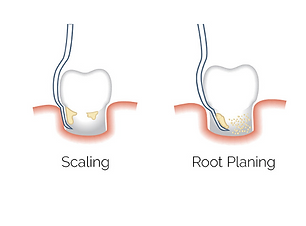

Keep Your Smile Healthy
Gum Therapy
Your gum (gingival) tissue forms an important barrier between your mouth and your underlying hard and soft tissues, therefore preventing microbes and debris from invading these areas and causing problems. Inflamed, sore, and bleeding gums are signs of gum disease (periodontal disease) and requires specialized therapy.
Gum disease, left untreated, will result in the loss of bone around the teeth which can eventually lead to tooth loss. If caught and managed early this process can be stopped and stable gum and bone health can be achieved once more.

Gum Disease Explained
Bleeding gums
Any bleeding of the gums should be considered a warning sign of gum disease.
Bad breath
It's very easy for plaque to collect in the spaces between and around teeth, therefore creating the perfect habitat for bacteria which produce odorous, sulfur-containing compounds resulting in bad breath.
Redness or swelling of the gums
Gingivitis, or gum inflammation, is usually the first visible sign of periodontal disease.
Receding gums
If you notice that your teeth look longer than they used to, or if you have gumline tooth sensitivity you may have some gum recession. Dr. Tatum can often help restore this loss of gum tissue with gum grafting.
Periodontal abscess
Bacteria can become enclosed in a deep gum pocket that is a result from bone loss. That bacteria will cause a painful infection in the area which may drain fluid and become swollen.
Loose teeth
When periodontal disease results in bone loss, teeth can become loose or migrate. Tooth loss can result and may be accelerated if you are applying excessive biting forces from clenching or grinding your teeth.

How Does Gum Therapy Work?
-
During your first visit or a normal cleaning visit, we will use a measuring instrument to gently check for pocketing within the gums. Deep pockets likely indicate your need for the most common periodontal therapy procedure called scaling and root planing, or deep cleaning.
-
This involves numbing of the affected area so your professional dental hygienist can effectively and comfortably eliminate plaque and tartar build-up from the teeth and root surfaces around and below the gumline. Our hygienist will perform the deep cleaning using manual scaling tools and/or electric or ultrasonic instruments for the best possible result. Nitrous oxide gas sedation is also available for your comfort as needed.

Continued Care
-
After your deep cleanings are completed we recommend completing maintenance cleanings every three months for at least one year. We will re-evaluate your gum health over time to ensure you are progressing and achieving better gum health!
-
Brushing at least twice per day and flossing at least once daily is a great way to keep your teeth AND your gums healthy for the rest of your life.

Free Cosmetic Consultation
Learn more without feeling pressured to make any kind of commitment. It's crucial that you take the time and effort to consider your options before you choose a restorative or cosmetic procedure, we will help you through the process!
